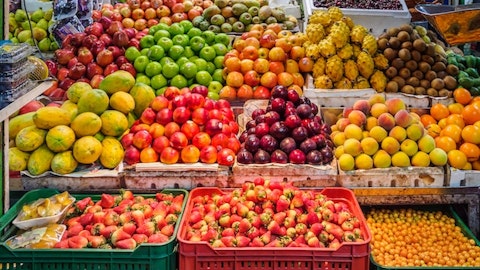One of the things that’s, there’s DNA about, there’s DNA in our company that people actually like working in an environment where they think they’re doing good for the good for the planet and good for the customers and good for the community. So, we feel as if retention, retention we know is in a good space, and applications are in a good space. So, labor isn’t, getting people in the stores isn’t a challenge. The 35 is more based on is there going to be some slippage from November, December into January next year.
Chip Molloy: Yeah. But I would also add that I, yeah, I think our store operations teams, our HR teams, marketing teams are doing a really nice job of building that muscle, of opening up quite a few stores in a short amount of time. If you just look at how many stores we opened this quarter, you know, that’s a pretty big number for us and we’re getting better at it each and every quarter. So, I think, the talent’s there and I think we’ve really developed the muscle in how to do it.
Krisztina Katai: That’s great. Thank you so much. Best of luck.
Operator: One moment for our next question and our next question comes from the line of John Heinbockel from Guggenheim Partners. Your question, please.
Unidentified Analyst: Morning, this is Anders Meyer on for Johnny Heinbockel. Can you walk us through how the produce distribution centers work, in terms of initial productivity and the path from margin dilution to accretion, and also how do you expect these DCs to benefit gross margin at maturity?
Chip Molloy: So, as it relates to the dilution, we added a lot — It’s DC dependent somewhat where it’s located, how many miles it’s going to take off the ground, how big it is? In this situation, we went to a much bigger DC in Southern California, so it’s bigger space that’s underutilized because we’re going to grow into it. And then we expanded a bunch of speeds in Texas. Again, we’re going to grow into it. So, from a dilution perspective, the expectation is they’re probably going to be dilutive for the first 12 months that they’re open. And then at that point, probably a push, and then you’ll get leverage probably you’ll probably get leverage out of it. It’s going to be 24 months out from opening the 36. You start to get some leverage because you’ve created real, you’ve created capacity that you’re now building into, that you’re starting to leverage.
Jack Sinclair: And the capacity will support the store programs that we’ve got in California. We’ve built distribution center in Florida that’s going to support it. We’ve built capacity in Dallas in Wilmer and Texas to support it. So, we’ve now got capacity to support the new stores that are coming on board, and going forward, it gives us some options in terms of distributing more broadly outside the produce space as well. So, it’s given us a lot of options in terms of efficiency and I’m anticipating that in the not too distant future, two three-year window, we’ll start to get some efficiencies in our distribution costs.
Unidentified Analyst: And to follow-up, what is the early read on the 2024 pipeline of stores, especially in the context of the new DC, So, I guess, the clustering by market?
Jack Sinclair : Well we said in our release that we think we’ll get approximately 35 stores in 2024. Beyond that, we’ve got a hundred sites that we’ve signed off in our real estate committees. And we’ve got 70 leases that are already signed. That continues. The real estate committee sees probably six, seven stores a month at the moment in terms of adding to this portfolio. So, we feel confident going through ‘24, ‘25, ‘26 that our store portfolio growth will be in line with what we’ve been anticipating all the way through. But ‘24 I think, specifically about we’re seeing approximately 35,
Chip Molloy: And I think maybe your question was leaning in towards like what markets and if that’s the case, it’s probably going to be about a 50-50 between what we call established and non-established markets. So, think about it from Florida up the east coast, it’s probably going to be 50% of those stores and the southwest to the west coast going to be the other 50%.
Operator: And our next question comes from the line of Chuck Cerankosky from Northcoast Research. Your question, please. Chuck, you might have your phone on mute. Still not hearing you, Chuck. Would you like me to move on to the next question?
Unidentified Company Representative : Yeah, let’s do that and then we can come back to Chuck if we can catch him at the end.
Operator: Our next question comes from the line of Kelly Bania from BMO Capital Markets. Your question, please.
Ben Wood: This is Ben Wood on for Kelly. Thank you for taking our questions. So, wanted to start by asking maybe the inflation question a little differently. We believe in the past; you guys have talked about Sprouts inflation tracking similar to food and home CPI, which we estimate decelerated about 300 basis points quarter-over-quarter. Wondering if that was consistent to the magnitude of slowdown you saw. And then can you provide any details on the subcategory level? Help us to understand pricing and units in some of your major categories like vitamins, produce, center store. And finally, you mentioned units are improving, but is that in the category’s you guys would have expected them to?
Chip Molloy: As it relates to the — if you take inflation, that’s probably about right. It’s not too far off. As it relates, I will skip to the unit one is — the units are, they are continuing to stabilize and that’s across, as we have mentioned many times, the area where we had our biggest challenge was in produce, which is, as we said, that was sort of a trade down, right? Our customers instead of trading down. They were trading out of a produce unit. We have the most number of units in the basket are produced and it is the lowest price point unit. We are beginning to see that stabilize as well. So, across our categories, it is getting — from a unit’s perspective, it is getting what I would call healthier in the fact that they are stabilizing. What was the other question, Ben?
Jack Sinclair: About the categories. So maybe I will be able to capture that a little bit, Ben. Our inflation number is always going to be a little bit different because of the mix dynamic in our business. There’s a little bit of it. Produce is always a bit more volatile, and we have got a bigger proportion of produce in our business. So, we have got to watch that. We have been encouraged by what has been happening in our produce business, as Chip said, in terms of your declining units just slowing down a little bit. And we are seeing some strength in our bananas business and avocados business, given we have invested a significant capability in terms of improving the quality, the freshness and the presentation of those products.
So, our produce business has seen some encouragement. I have been really pleased by dairy, frozen grocery where we get real attribute differentiation, and that’s flowing through really strongly in terms of our business. And it is probably slowing down a little bit in terms of inflation in that space as well, inline with what you talked about in terms of your question. So, we are feeling that, there is dynamics that change our inflation number. But the overall story that Chip has been, we have been talking about now in the call and in previous calls, where you see a slowing down of the level of AUR growth, and the decline in units is slowing down at the same time. So, it is coming into sync, which is what we think is going to happen going forward.



